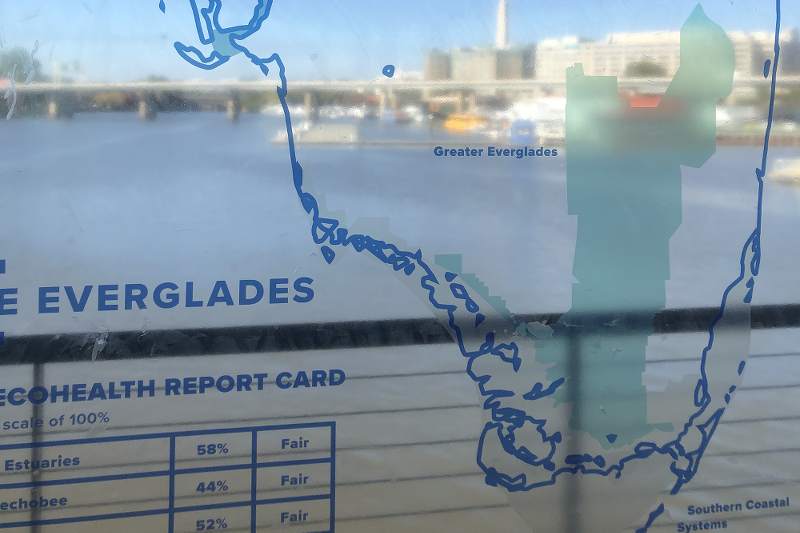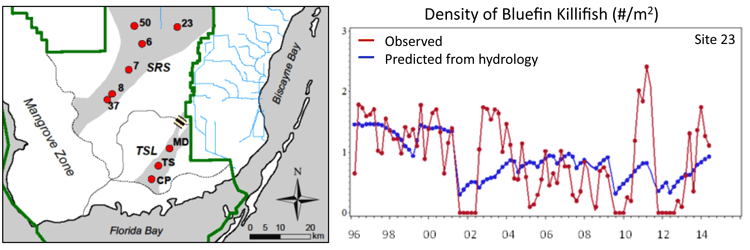Collaborating with agency scientists, FCE scientists developed an effective communication tool for directly informing the U.S. Congress and other decision makers about the science of Everglades restoration.
- Key Findings
Though much of the Everglades is Federally designated Wilderness, it is also a human-dominated landscape that is sensitive to manipulations of water delivery and quality. Working with a State-Federal task force, FCE contributes to a reporting system linking the causes and consequences of these dynamics and communicating the results in a format accessible to a wide audience. This reporting system is used in bi-annual reports to the U.S. Congress by the South Florida Ecosystem Restoration Task Force to assess progress in ecosystem restoration. The "stoplight" reporting system allows us to communicate our results to other scientists and policy makers through a multi-layered reporting tool that extracts management signals from long-term datasets.

Photo taken through a transparent image of the Everglades Report Card looking to the Washington Monument from the District Wharf in Washington, D.C., where "The Future of Water" fly-in was held in the fall of 2019. Credit: Evelyn Gaiser The reporting system includes 11 indicator types that address diverse spatial and ecological dimensions of the Everglades restoration initiative. Three of the indicators, periphyton-epiphyton, fish and macroinvertebrates, and Florida algal blooms, are closely linked to our core research topics and long-term data gathering. Our scientists participated in a team of the Federal Task Force on Everglades Restoration, National Park Service, US Army Corps of Engineers, US Fish and Wildlife Service and other universities to develop this communication tool.
- Results

Time series data from each site are compared to targets derived from a model linking rainfall and baseline conditions identified as approximating historical hydrological conditions. Developed from Trexler and Goss (2009).

An example report card with stoplights indicating compliance with targets (green), deviation from targets that require ongoing attention (yellow), and deviation from targets indicating a failure to meet management goals (red).
- Related Publications
Beerens, J.M., J.C. Trexler, and C.P. Catano. 2017. Predicting wading bird and aquatic faunal responses to ecosystem restoration scenarios. Restoration Ecology 25: S86-S98. DOI: 10.1111/rec.12518
Borkhataria, R., P. Wetzel, H. Henriquez, and S.E. Davis. 2017. The Synthesis of Everglades Restoration and Ecosystem Services (SERES): a case study for interactive knowledge exchange to guide Everglades restoration. Restoration Ecology 25: S18-S26. DOI: 10.1111/rec.12593
Boyer, J. N., C. R. Kelble, P. B. Ortner, and D. T. Rudnick. 2009. Phytoplankton bloom status: An indicator of water quality condition in the southern estuaries of Florida, USA. Ecological Indicators 9s: s56-s67.Doren, R. F., J. C. Trexler, A. D. Gottlieb, and M. Harwell. 2009. Ecological indicators for system-wide assessment of the Greater Everglades Ecosystem Restoration Program. Ecological Indicators 9:S2-S16.
Gaiser, E. 2009. Periphyton as an indicator of restoration in the Everglades. Ecological Indicators. 9: S37-S45.
Naja, M., D.L. Childers, and E.E. Gaiser. 2017. Water quality implications of hydrologic restoration alternatives in the Florida Everglades, United States. Restoration Ecology 25: S48-S58. DOI: 10.1111/rec.12513
Trexler, J. C., and C. W. Goss. 2009. Aquatic fauna as indicators for Everglades restoration: Applying dynamic targets in assessments. Ecological Indicators 9S:S108-S119.
Wetzel, P., J.P. Sah, and M.S. Ross. 2017. Tree islands: the bellwether of Everglades ecosystem function and restoration success. Restoration Ecology 25: S71-S85. DOI: 10.1111/rec.12428
Wetzel, P., S.E. Davis, T. Van Lent, S.M. Davis, and H. Henriquez. 2017. Science synthesis for management as a way to advance ecosystem restoration: evaluation of restoration scenarios for the Florida Everglades. Restoration Ecology 25: S4-S17. DOI: 10.1111/rec.12566
Fore more information, contact Joel Trexler.